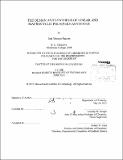| dc.contributor.advisor | Timothy M. Swager. | en_US |
| dc.contributor.author | Batson, Joel Marcus | en_US |
| dc.contributor.other | Massachusetts Institute of Technology. Department of Chemistry. | en_US |
| dc.date.accessioned | 2013-11-18T19:07:13Z | |
| dc.date.available | 2013-11-18T19:07:13Z | |
| dc.date.copyright | 2013 | en_US |
| dc.date.issued | 2013 | en_US |
| dc.identifier.uri | http://hdl.handle.net/1721.1/82311 | |
| dc.description | Thesis (Ph. D.)--Massachusetts Institute of Technology, Dept. of Chemistry, 2013. | en_US |
| dc.description | Cataloged from PDF version of thesis. | en_US |
| dc.description | Includes bibliographical references. | en_US |
| dc.description.abstract | Poly(para-phenylene) (PPP) has generated sustained scientific interest due to its potential as a blue-emitting material for use in Organic Light Emitting Devices (OLEDs). However, due to its highly unfavorable solubility, most traditional synthetic routes to PPP are relatively limited in their scope. In Chapter 2 we discuss the synthesis of poly(para-arylene)s via the post polymerization functionalization of a completely soluble and easily accessible precursor polymer, utilizing the metal-catalyzed [2+2+2] reaction. We expect that this versatile strategy could lead to new and interesting PPP derivatives. In Chapter 3, we employed this [2+2+2] strategy once more in the synthesis of an defective, but otherwise inaccessible alkoxy substituted poly(phenylene triptycene). We discuss the limitations of this synthetic route for the installation of the three-dimensional triptycene scaffold along the polyphenylene backbone. Recent interest in belt-shaped p-polyarylene macrocycles, otherwise known as nanohoops, has been high due to their potential as a starting template for the bottom-up synthesis of armchair carbon nanotubes (CNTs). The proposed strategy involves iterative Diels-Alder cycloadditions performed in the bay-region of a structurally appropriate nanohoop. However, the unique geometry of these macrocycles also makes them relatively challenging synthetic targets. Perylene has been identified as the smallest polycyclic aromatic hydrocarbon (PAH) capable of undergoing a Diels-Alder in its bay-region. Accordingly, in Chapter 4 we discuss progress towards the synthesis of a nanohoop containing this crucial perylene moiety, from which it is hoped the aforementioned bottom-up synthetic strategy can be successfully implemented. | en_US |
| dc.description.statementofresponsibility | by Joel Marcus Batson. | en_US |
| dc.format.extent | 124 p. | en_US |
| dc.language.iso | eng | en_US |
| dc.publisher | Massachusetts Institute of Technology | en_US |
| dc.rights | M.I.T. theses are protected by
copyright. They may be viewed from this source for any purpose, but
reproduction or distribution in any format is prohibited without written
permission. See provided URL for inquiries about permission. | en_US |
| dc.rights.uri | http://dspace.mit.edu/handle/1721.1/7582 | en_US |
| dc.subject | Chemistry. | en_US |
| dc.title | The design and synthesis of linear and macrocyclic Poly(para-arylene)s | en_US |
| dc.type | Thesis | en_US |
| dc.description.degree | Ph.D. | en_US |
| dc.contributor.department | Massachusetts Institute of Technology. Department of Chemistry | |
| dc.identifier.oclc | 861598245 | en_US |
